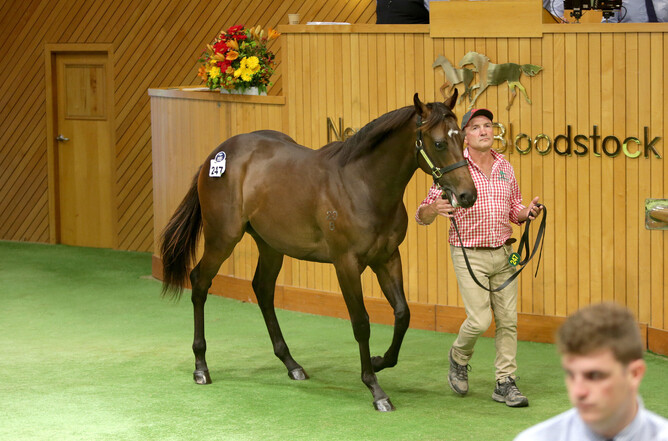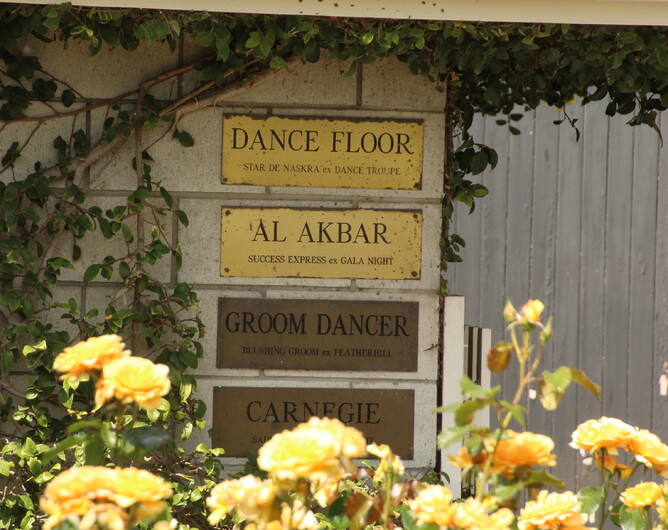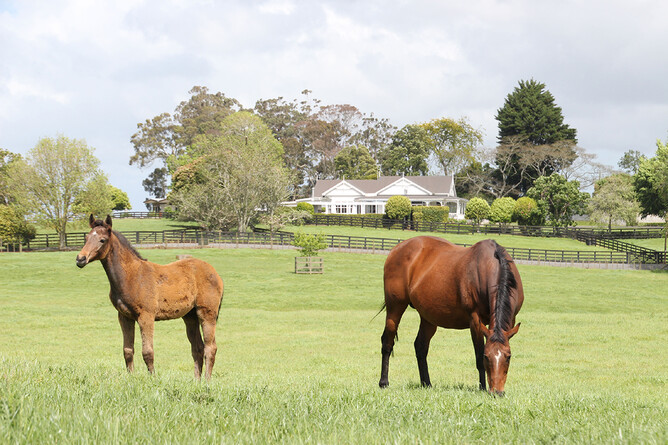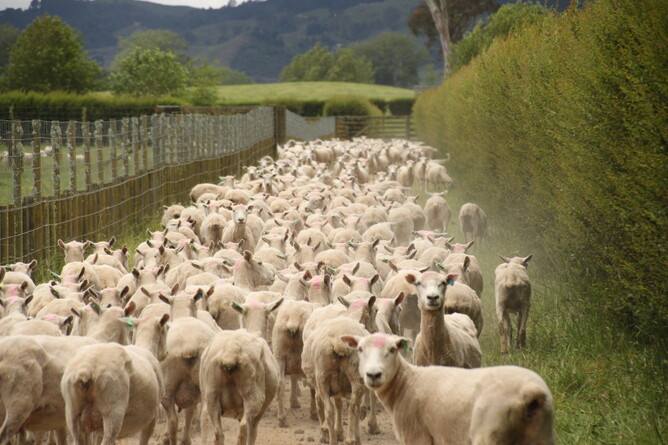The 2020 New Zealand Bloodstock Karaka Yearling Sale saw a major change to the Taylor family's selling model, a move that paid dividends with Trelawney Stud being the sale's leading vendor by average. TDN AUS NZ's Trevor Marshallsea sat down with the Taylors to hear about this new stage for the farm and the history behind it.
Forward thinking and looking to the future have been hallmarks in the success of two of the most familiar names in New Zealand breeding, Brent and Cherry Taylor.
But Trelawney Stud’s owners are hoping the clock has already started turning back a couple of decades.
Karaka 2020 was a tantalising flashback for a few reasons. The Taylors took the major step of offering only their own yearlings, rather than selling for other clients as they’d done for many years.
And one of those who snapped up two of them was a blast from some glorious past.
Having announced his return to training around the same time, Peter Moody bought two lots from the Taylors. He paid NZ$450,000 ($429,000) for an Ocean Park filly, out of the dual G2 winning Ruud van Slaats (NZ) (Van Nistelrooy {USA}). He then paid NZ$500,000 ($477,000) for a filly by Exceed And Excel out of Bernardini (USA) mare Gallwitz. Moody’s clients for both were two of his most loyal owners from his Brisbane days.
Go back a couple of decades, and Ron and Judy Wanless went to Karaka and bought a colt bred by the Taylors by their resident stallion Carnegie (Ire). They entrusted him to Moody and, racing as Amalfi, the colt provided the first Group 1 success for trainer and owners in the 2001 VRC Derby, also bringing the Taylors one of their biggest thrills in breeding.
If the Taylor-Moody-Wanless triumvirate can enjoy at least some success through these two fillies, it would bring the Waikato breeders another of those special feelings the thoroughbred world can bring but which words can fall short of describing.
“It’s great to see Pete coming back,” Cherry says. “We love Pete and his wife Sarah and in fact the whole family. We had one of their daughters come over and work with us on the farm for a while. They’re one of those special connections you make in racing. And the fact he’s bought these two horses for the Wanlesses just tops it off.”
Karaka was an unqualified success for the Taylors and Trelawney, the famed stud which can boast to having produced seven Melbourne Cup winners and two Cox Plate victors – one of them the incredible Tulloch.
Trelawney offered 11 lots and yielded NZ$3.5 million ($A3.34 million), making them the sale’s leading vendor by average ($314,000/$A299,000). Their top price was NZ$625,000 ($A597,000) paid by prominent agent David Ellis for a colt by I Am Invincible out of Sancerre (NZ) (O’Reilly {NZ}), who is expected to race in New Zealand.
The results brought instant validation for the Taylors, who two years ago bit the bullet by telling clients they would from this year be taking only their own horses to sales.
“Cherry and I decided we needed to get ourselves in position for our next stage of our life in breeding with our own stock,” says Brent. “This is the first sale where we’ve sold just our own yearlings, whereas in the past we’d have drafts of 30 or 40, mostly owned by other people.”
“You only get what you breed,” says Cherry, reflecting on their “amazing” sale. “Even the best-bred horse can come out with conformational problems. But this was a really good bunch on type, and from some fantastic families who are really performing on racetracks right now, which is a key factor.”
“Our staff did a great job. We try to present them in the same way every year. They do similar types of exercise, and Brent adjusts the feeding depending on what results come back from our soil tests, so we can have these yearlings looking their best.”
Aside from the horses, 57-year-old Brent looks after the soil and other aspects of farming, like Trelawney’s extensive numbers of cattle (180-odd) and 2000-plus sheep.
Cherry, 59, combines with her husband on breeding matters, sourcing stock, and sales selection (typically an annual hit list of Karaka, Sydney Easter and one or two broodmare sales). She’s also well known throughout the Australasian thoroughbred world for her second business, equine insurer CN Taylor Consulting.
That would be a comforting fallback - insurance, if you will, against harsh times - but throughout Trelawney’s illustrious history those have been few and far between.
Trelawney was established in 1930 by Seton Otway, who became a byword in Australasian breeding. Seven Melbourne Cups – from Hiraji (1947) to Silver Knight (1971) and with the great Galilee (1966) in their midst - and two Cox Plates will do that for you.
Australian billionaire Robert Holmes a’Court bought the farm in 1987, before his sudden death in 1990 led to the purchase by Brent Taylor’s parents Keith and Faith, with Brent managing operations. He and Cherry took up ownership in 2010.
“There’s no one ingredient that goes into success. There’s a whole variety,” says Brent, who can look back proudly on 41 G1 wins from 28 G1 winners during the couple’s time at the 485-acre farm.
“You’ve got to start with the idea that good farms produce good stock, be it cattle, sheep, whatever.
New Zealand is a very forgiving farming country, and this farm, with its quality of land, could rear anything,” says Brent, almost as proud of his 2100 head of sheep and 200-odd head of cattle as his thoroughbreds.
“You need other stock to complement horses. Horses are browsers, not grazers, so they’re not particularly efficient when it comes to creating good pasture. That’s where the sheep and cattle come into it.”
The Taylors have not looked back since making another major decision several years ago. Rather than standing their own stallions, they now have shares in around eight of them, all in New Zealand. Some keen investment in fillies in the past several years is now starting to translate into a very high quality broodmare band, which now numbers around 35.
“You either have to be huge in stallions and have 200 mares so you can support them all, or take a different approach,” says Cherry, who will send two colts to Easter, by Savabeel and Lonhro.
“Only a tiny percentage of stallions make it, and by the time you’ve sent your mares to your stallion for five or six years to see if he’s any good, often you pollute those good mares.”
Brent, who backed into a breeding life in Kentucky in the early 1980s when his work in sheep and cattle ran out, has some finely honed rules when it comes to Trelawney’s broodmares.
“I just pick mares with proven pedigrees, by proven stallions, and who are out of mares by proven stallions,” he says. “At auction, I’ll only ever buy mares who are either maiden mares or in foal the first time. I can make my own mistakes in breeding horses. I don’t need to take up someone else’s mistakes.”
After NZ-based stallions, the Taylors’ secondary strategy is to send a mare to an Australian stallion, and bring her home with that foal at foot, and in foal a second time. Nine of their mares crossed the Tasman last year.
Budgets below some of the bigger hitters in Australia mean the Taylors also have to be particular, and must time their run.
“Stallions go in and out of favour. To be able to get value out of them, you need to use them when they’re out of favour a bit,” says Brent, conceding I Am Invincible’s rise to a $248,000 service fee has now put him out of their market.
“It’s very hard to get a return from that service fee, which is what we’re about. I might sit back now and see if the heat comes out of the market for that stallion, like it has with Fastnet Rock. He use to command a very high fee, but he’s much more affordable now,” Taylor says of the 19-year-old, who stood for $165,000 last year.
“You do have to factor in the age of the stallion, too. I certainly don’t like sending old mares to old stallions. I’m more likely to send a young mare to an older stallion.
“Mind you, there are no young proven stallions. It takes time. All proven stallions have a bit of age on them, like Written Tycoon, who’s reached his peak success as an older horse.”
Under the Taylors’ carefully tuned approach, Trelawney’s reputation as one of the finest producers of thoroughbreds in a land renowned for the habit looks certain to continue for many years to come. - Trevor Marshallsea, TDN AUS NZ




